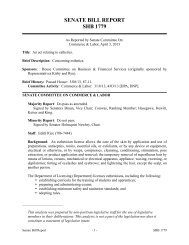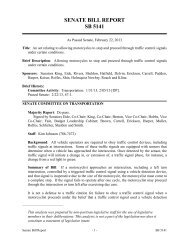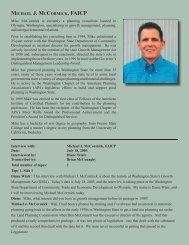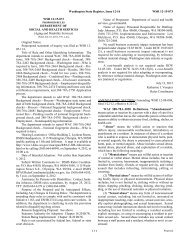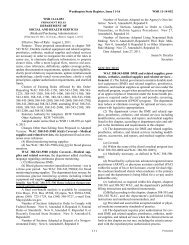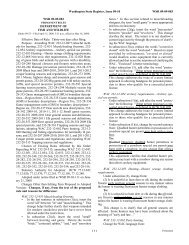Proposed
Proposed
Proposed
You also want an ePaper? Increase the reach of your titles
YUMPU automatically turns print PDFs into web optimized ePapers that Google loves.
1. How would the proposal be likely to increase discharge<br />
to water; emissions to air; production, storage, or release<br />
of toxic or hazardous substances; or production of noise?<br />
<strong>Proposed</strong> measures to avoid or reduce such increases are:<br />
2. How would the proposal be likely to affect plants, animals,<br />
fish, or marine life?<br />
<strong>Proposed</strong> measures to protect or conserve plants, animals,<br />
fish, or marine life are:<br />
3. How would the proposal be likely to deplete energy or<br />
natural resources?<br />
<strong>Proposed</strong> measures to protect or conserve energy and<br />
natural resources are:<br />
4. How would the proposal be likely to use or affect environmentally<br />
sensitive areas or areas designated (or eligible<br />
or under study) for governmental protection; such as<br />
parks, wilderness, wild and scenic rivers, threatened or<br />
endangered species habitat, historic or cultural sites,<br />
wetlands, flood plains, or prime farmlands?<br />
<strong>Proposed</strong> measures to protect such resources or to avoid<br />
or reduce impacts are:<br />
5. How would the proposal be likely to affect land and<br />
shoreline use, including whether it would allow or<br />
encourage land or shoreline uses incompatible with<br />
existing plans?<br />
<strong>Proposed</strong> measures to avoid or reduce shoreline and land<br />
use impacts are:<br />
6. How would the proposal be likely to increase demands<br />
on transportation or public services and utilities?<br />
<strong>Proposed</strong> measures to reduce or respond to such<br />
demand(s) are:<br />
7. Identify, if possible, whether the proposal may conflict<br />
with local, state, or federal laws or requirements for the<br />
protection of the environment.<br />
Washington State Register, Issue 12-21 WSR 12-21-132<br />
WSR 12-21-132<br />
PROPOSED RULES<br />
DEPARTMENT OF AGRICULTURE<br />
[Filed October 24, 2012, 9:50 a.m.]<br />
Original Notice.<br />
Preproposal statement of inquiry was filed as WSR 12-<br />
18-076.<br />
Title of Rule and Other Identifying Information: Chapter<br />
16-474 WAC, Eastern filbert blight quarantine. The<br />
department is proposing to establish a quarantine that would<br />
place restrictions on the importation of hazelnut plants into<br />
Washington state in response to eastern filbert blight.<br />
Hearing Location(s): Washington State Department of<br />
Agriculture, 117 North First, Suite 39, 2nd Floor, Mt. Vernon,<br />
WA 98273, on November 29, 2012, at 11:00 a.m.<br />
Date of Intended Adoption: December 6, 2012.<br />
Submit Written Comments to: Henri Gonzales, P.O.<br />
Box 42560, Olympia, WA 98504-2560, e-mail hgonzales@<br />
agr.wa.gov, fax (360) 902-2094, by November 29, 2012.<br />
Assistance for Persons with Disabilities: Contact Henri<br />
Gonzales by November 20, 2012, TTY (800) 833-6388 or<br />
711.<br />
Purpose of the Proposal and Its Anticipated Effects,<br />
Including Any Changes in Existing Rules: At the request of<br />
Washington's filbert growers, the department is proposing to<br />
establish a quarantine that requires hazelnut planting stock<br />
from states east of the Rocky Mountains, including all of<br />
Montana, Wyoming, Colorado, and New Mexico, to originate<br />
from an area free of the fungus Anisogramma anomala<br />
or be micro-propagated and shipped in artificial culture<br />
media in a sealed container. In addition, the quarantine<br />
requires hazelnut planting stock from all other states to be<br />
inspected during the last growing season and found free of<br />
eastern filbert blight. Establishment of a quarantine may better<br />
protect the commercial hazelnut industry from an economically<br />
significant plant disease.<br />
Reasons Supporting Proposal: Eastern filbert blight is a<br />
highly infectious plant disease affecting hazelnuts (also<br />
called filberts) and closely related species. It is caused by the<br />
fungus Anisogramma anomala. Until recently, varieties of<br />
hazelnuts grown in the Pacific Northwest were resistant to<br />
the local strain of A. anomala. However, more virulent<br />
strains of A. anomala have been found in the eastern portion<br />
of the United States. If these more virulent, exotic strains are<br />
introduced into Washington, the disease resistance of local<br />
commercial and ornamental varieties of hazelnuts will<br />
decline and may be lost, resulting in potentially devastating<br />
economic consequences to growers, loss of ornamental or<br />
landscape hazelnut plants, and environmental consequences<br />
of removing habitat and food sources for wildlife. Members<br />
of the Washington industry have requested that the department<br />
consider a rule to protect the local crop.<br />
Statutory Authority for Adoption: RCW 17.24.041,<br />
15.13.260, and chapter 34.05 RCW.<br />
Statute Being Implemented: RCW 17.24.041.<br />
Rule is not necessitated by federal law, federal or state<br />
court decision.<br />
Name of Proponent: Growers Society of Oregon, Washington<br />
& British Columbia, private.<br />
[ 179 ] <strong>Proposed</strong>



